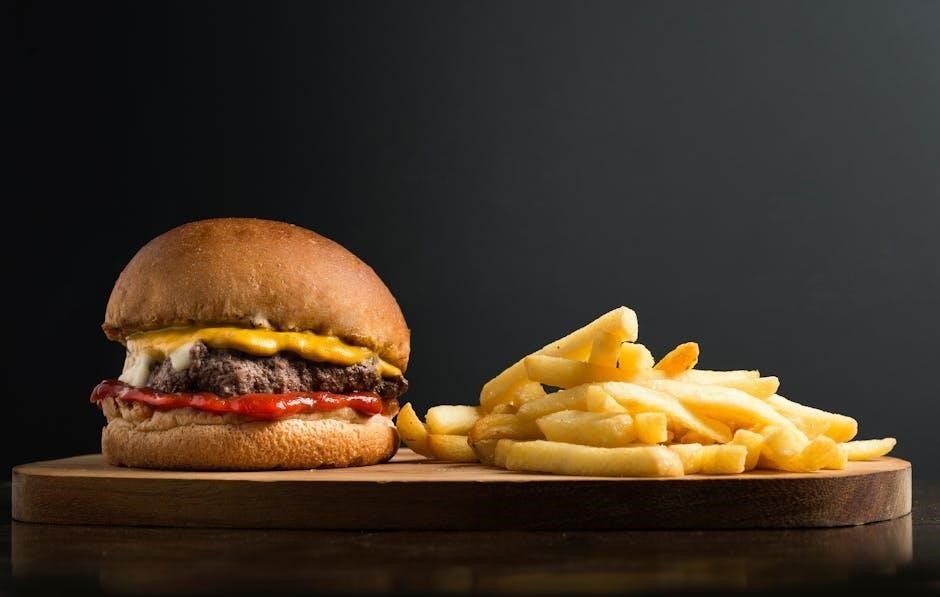A structured approach to weight loss, the 1100-calorie meal plan provides a daily calorie distribution across three meals, supporting fat loss while meeting nutritional goals. Customize it with sample menus like the Mexican American plan, ensuring variety and adherence to dietary preferences.
1.1 Understanding the Basics of a 1100 Calorie Diet

A 1100-calorie diet is a low-calorie meal plan designed to promote weight loss by creating a calorie deficit. It typically involves distributing calories across three main meals and snacks, ensuring nutrient balance. Breakfast, lunch, and dinner are portion-controlled, with calorie counts allocated to each meal. Snacks are optional but should be low-calorie and nutrient-rich. The diet emphasizes protein, fiber, and healthy fats to maintain satiety and energy levels. It is often tailored to individual needs, such as dietary restrictions or preferences. While effective for weight loss, it is important to consult a healthcare professional to ensure it meets nutritional requirements and is safe for long-term use. Customization and gradual adjustments are key to sustaining this diet plan.
1.2 Benefits of a Low-Calorie Meal Plan for Weight Loss
A 1100-calorie meal plan is an effective strategy for weight loss, offering several key benefits. By restricting daily calorie intake, it creates a calorie deficit, essential for shedding pounds. This structured approach helps individuals stick to their weight loss goals by providing clear portion control and meal guidance. It also promotes healthier eating habits, such as choosing nutrient-dense foods and reducing reliance on high-calorie, low-nutrient options. Additionally, a low-calorie diet can improve metabolic function and increase fat oxidation, enhancing overall weight loss efficiency. Customizable meal plans allow individuals to tailor their diets to personal preferences, ensuring long-term adherence. However, it’s crucial to balance calorie restriction with adequate nutrition to avoid deficiencies and maintain energy levels throughout the day. Consistency and patience are key to achieving sustainable results with this plan.
Daily Meal Structure
The 1100-calorie meal plan is spaced over 5 meals, including 3 main meals and 2 snacks, creating a calorie deficit to promote weight loss effectively.
2.1 Breakfast Options for a 1100 Calorie Meal Plan
Breakfast options for a 1100-calorie meal plan should be nutrient-dense and low in calories. Consider starting with a 6-inch whole wheat tortilla, one egg, and 6 oz of low-fat yogurt, totaling around 250 calories. This combination provides protein, fiber, and essential vitamins to kickstart your day. Alternatively, opt for oatmeal with berries or a smoothie made with spinach, banana, and almond milk. These options are not only delicious but also help maintain a calorie deficit while keeping you full. Ensure your breakfast includes a balance of carbs, protein, and healthy fats to support energy levels and weight loss goals.
2.2 Lunch Ideas to Stay Within Caloric Limits
Lunch should be balanced, nutrient-rich, and low in calories. Opt for lean proteins like grilled chicken or turkey, paired with vegetables and whole grains. A salad with mixed greens, cherry tomatoes, cucumber, and a light vinaigrette, alongside a small portion of quinoa or brown rice, makes a satisfying meal. For variety, try a whole wheat wrap with roasted chicken, lettuce, and low-fat hummus. Portion control is key to staying within your caloric limits. Aim for meals that provide around 300-350 calories, ensuring you maintain energy levels while supporting your weight loss goals. Incorporate colorful vegetables and fiber-rich foods to keep you full and satisfied until dinner.
2.3 Dinner Recipes for a Balanced Low-Calorie Diet
Dinner should emphasize lean proteins, vegetables, and whole grains to maintain nutritional balance while keeping calories low. Try baked or grilled chicken breast seasoned with herbs, served with steamed broccoli and a small portion of quinoa; For variety, include fish like salmon or cod, which are rich in omega-3 fatty acids, paired with roasted vegetables and a side of brown rice. Veggie-packed stir-fries with tofu or shrimp, cooked in a little olive oil and soy sauce, are also great options. Aim for meals that provide around 300-350 calories, ensuring you stay within your daily limit. Incorporate seasonal vegetables to keep meals fresh and flavorful, and avoid heavy sauces or oils to maintain a healthy profile.
2.4 Healthy Snack Choices to Support Weight Loss
Snacks play a crucial role in curbing hunger and preventing overeating at meals. Opt for low-calorie, nutrient-dense options like fresh fruits, raw vegetables, or a handful of nuts. A small serving of plain, low-fat yogurt with berries or a slice of whole-grain toast with avocado can satisfy cravings while staying within your calorie goals. Veggie sticks with a light hummus dip or a hard-boiled egg are also excellent choices. Portion control is key, as even healthy snacks can add up in calories. Aim for snacks under 100-150 calories to support your weight loss journey without compromising your dietary goals. Avoid sugary or processed snacks, and focus on whole, unprocessed foods to maintain a balanced and satisfying diet.

Customizing Your 1100 Calorie Meal Plan
Personalize your plan by swapping meals, adjusting portion sizes, and incorporating dietary preferences. Tailor recipes to suit your taste, budget, and schedule for a flexible weight-loss approach.
3.1 Adjusting for Dietary Preferences and Restrictions
Modify the 1100-calorie meal plan to suit your dietary needs, such as vegetarian, vegan, or gluten-free options. Swap ingredients like eggs with tofu or use gluten-free grains. Incorporate preferences like Mexican-inspired dishes or low-fat dairy alternatives. Utilize tools like Eat This Much to personalize recipes and ensure meals align with your lifestyle and restrictions while maintaining the calorie goal. This flexibility ensures the plan remains enjoyable and sustainable for long-term weight loss.
3.2 Incorporating Nutritional Goals and Preferences
Align the 1100-calorie meal plan with your nutritional goals, such as increasing protein intake or reducing carbohydrates. For instance, include lean proteins like egg whites or cottage cheese to support muscle retention. Adjust macronutrient ratios, lowering carbs to 45-50 grams if aiming for fat loss. Incorporate tools like Eat This Much to tailor recipes based on preferences, ensuring meals are balanced and nutrient-dense. This approach allows for personalization, whether you prefer low-carb, high-protein, or plant-based options, while maintaining the calorie deficit needed for weight loss. Regularly review and adapt the plan to ensure it meets your evolving nutritional needs and keeps meals enjoyable.

Benefits and Safety of the 1100 Calorie Meal Plan
Promotes sustainable weight loss by creating a calorie deficit while maintaining nutritional balance. Ensures safety through balanced meals, avoiding extreme deprivation, and providing essential nutrients for overall health.
4.1 Promoting Sustainable Weight Loss
A 1100-calorie meal plan supports sustainable weight loss by creating a calorie deficit while maintaining nutritional balance. This approach prevents extreme hunger, making it easier to adhere to long-term. It focuses on balanced meals, ensuring essential nutrients are met, which helps preserve muscle mass and boosts metabolism. Additionally, the plan allows for customization, enabling individuals to tailor meals according to preferences and dietary needs. Over time, this structured eating pattern fosters healthier eating habits, contributing to gradual and maintainable weight loss. By combining a reduced-calorie intake with nutrient-dense foods, the plan effectively promotes fat loss without sacrificing overall health or energy levels.

4.2 Ensuring Nutritional Balance and Safety
A 1100-calorie meal plan prioritizes nutritional balance by incorporating essential vitamins, minerals, and macronutrients. It ensures adequate protein intake to maintain muscle mass, balances carbohydrates for energy, and includes healthy fats for optimal bodily functions. The plan emphasizes whole, nutrient-dense foods, such as vegetables, lean proteins, and whole grains, to meet dietary needs. Portion control and meal spacing help prevent nutrient deficiencies while promoting safety. Regular monitoring of nutritional intake ensures the plan aligns with health guidelines, making it suitable for most individuals seeking weight loss. By focusing on balanced eating, the plan minimizes potential risks associated with very-low-calorie diets, ensuring overall health and well-being are maintained throughout the weight loss journey.

